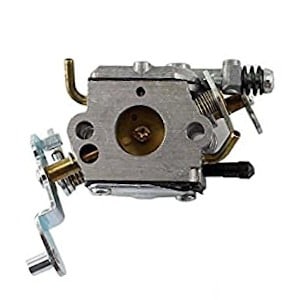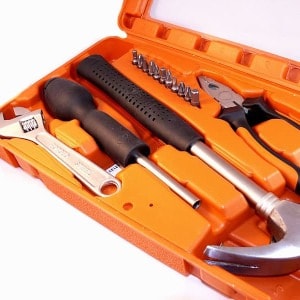 Carburetors are extremely complicated. Learning how to adjust your chainsaw carburetor is necessary to keep your chainsaw working smoothly at all times. If your carburetor is properly adjusted, you have maximum power, very little smoke, and the machine will idle and run like a dream.
Carburetors are extremely complicated. Learning how to adjust your chainsaw carburetor is necessary to keep your chainsaw working smoothly at all times. If your carburetor is properly adjusted, you have maximum power, very little smoke, and the machine will idle and run like a dream.
If your carburetor is not adjusted properly, you may have too much smoke, not enough power, and this will ultimately cause damage to your engine. If you want your saw to do its job properly, simply follow the easy steps in this guide on how to adjust your chainsaw carburetor.
There are three main adjustment settings. There is an adjustment for the idle speed and the throttle stop, the low-speed fuel adjustment, and the high-speed fuel adjustment. It is important that each one works properly for your chainsaw to run. These adjustments typically come in the form of a screw on your carburetor.
Idle Speed/Throttle Stop
This is the adjustment on your carburetor that controls exactly how much the throttle valve will stay open when you release the trigger. Basically, it is all about how well your chainsaw idles once you have taken your finger off the trigger.
If the adjustment is set too low, your engine will die the second you release the trigger because the throttle valve closed immediately. On the other hand, if the adjustment is too high, your chainsaw is going to idle very quickly, which will cause the chain to spin whether you want it to be running or not. This can be extremely dangerous since the chain is spinning while your finger is not on the trigger.
Low-Speed Adjustment
The low-speed adjustment controls how much fuel is inside of the air/fuel mixture while at idling speed. If your adjustment is too rich, the engine will be loaded with too much fuel and it will die once idling. On the other hand, if the mixture is too low, there won’t be enough fuel in the mixture, which will either cause the engine to die also, or to surge.
Read More: How To Connect Throttle Cable To Carb – Fix It Yourself!
High-Speed Adjustment
 This is the same as the low-fuel adjustment, only it determines how much fuel is added to the air/fuel mixture when you are at cutting speed. Basically, this adjustment will determine exactly how the saw is going to run while cutting through wood. This may seem like the most important setting, but the fact is that all three need to be perfect for your chainsaw to run properly.
This is the same as the low-fuel adjustment, only it determines how much fuel is added to the air/fuel mixture when you are at cutting speed. Basically, this adjustment will determine exactly how the saw is going to run while cutting through wood. This may seem like the most important setting, but the fact is that all three need to be perfect for your chainsaw to run properly.
If this adjustment is too high, your saw will not be able to reach the maximum RPM level that it needs to build power to cut. You will also have slow throttle response, the engine will smoke, and the entire piece of equipment will perform poorly.
A mixture that is too low will have the opposite effect. The engine will reach maximum RPM very quickly, but then the cylinder will likely seize and your chainsaw will no longer have the power to cut properly. Your chainsaw will also get super hot, which causes a whole other list of problems.
How to Adjust Your Chainsaw Carburetor
 Step 1: First you need a flathead screwdriver that is small enough to fit through the adjustment holes. These are the holes on the carburetor in which you must insert the screwdriver to turn the adjustment screw. Clear the holes of any debris so that you can see the ends of the adjustment screws inside.
Step 1: First you need a flathead screwdriver that is small enough to fit through the adjustment holes. These are the holes on the carburetor in which you must insert the screwdriver to turn the adjustment screw. Clear the holes of any debris so that you can see the ends of the adjustment screws inside.
Step 2: Before you adjust the carburetor, clean the air filter. Make sure there is no debris or dust clogging the air filter, otherwise this can cause abnormalities while adjusting the carburetor.
Step 3: Make sure you have about half a tank of fuel. If the carburetor is adjusted with no fuel in the tank, things can change once the fuel tank is full, which can lead to adjustments that are too rich.
Step 4: Warm the engine. You always want the engine to run for a few minutes to get it warm before you start your adjustments, otherwise, you will also have inconsistencies. Once the chainsaw is warm, begin the procedure.
Step 5: First is the idle speed. Your target should be about 2,700 RPM. Use the screwdriver to turn the screw and make the adjustment, trying to set the speed so that the chainsaw idols without the chain moving. Test it out until you get it perfect.
Step 6: Now you set the low-speed adjustment. You want to slowly turn the screw inwards until the engine starts surging, meaning it is starved for fuel. Make a note of where the location on the screw is.
Next, turn the screw all the way in the other direction until the engine is really revving. Make a note of this location. Now turn the screw until it is midway between maximum revving and total fuel starvation. This will be the sweet spot.
Step 7: Repeat step 4, setting the idle speed so that it is perfect. Your previous adjustment likely changed something, and now the idle speed must be re-tuned.
Step 8: Now it is time to set the high-speed adjustment. You want the chainsaw to blubber when the throttle is wide open, but you don’t want the RPMs to be wildly out of control. This can be tricky without a tachometer, but you can usually find a sweet spot just below max RPM.
The sound your chainsaw should make when adjusted properly is somewhere between the smooth sound of when it is starved for fuel and the gravelly sound of when it has too much power. The sound should be right in the middle, a little rough but not too crazy. You can experiment by turning the adjustment all the way to the left, then to the right, then finding the mid-point.
Step 9: Repeat step 4 and re-tune the idle speed once more. Every time you adjust one of the screws, you must go back and adjust the idle speed. Once you’ve finished this final adjustment, that’s it. You are now done. Your carburetor is adjusted, and your chainsaw is ready to work.
Read More: How To Clean Chainsaw Air Filter – 3 Simple Steps

